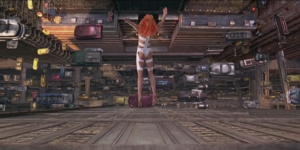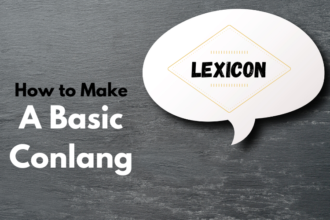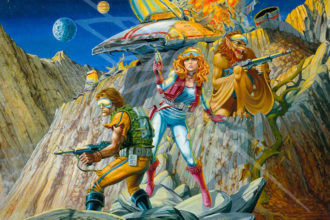The Fifth Element and Homebrewed Campaign Worlds

On this episode of “we’re all older than dirt and marching toward our inevitable deaths,” you will discover that The Fifth Element just turned twenty years old on May 7th. Why was this movie not released on May 5th for some synergy on the fives? I don’t know, because of France, maybe? Regardless, this film was a runaway success when it was released – despite it being one of the more bizarre summer blockbusters to hit the screen. It might be strange to think of now, but this film was incredibly polarizing upon release. Critics panned the movie, calling it unhinged, terrible, and even good reviews called it only campy and fun. It’s an incredibly divisive film. It was nominated for actual prestigious awards (César Awards, Cannes Film Festival, European Film Awards, BAFTAs, Academy Awards) and then was nominated for two Golden Raspberries (Razzies) for Milla Jovovich and Chris Tucker. I fall firmly in the camp that this movie is a masterpiece. It’s a glorious pulpy space fantasy obviously inspired by the Incal and Valérian and Laureline (which we have a feature length film of soon, yay!), but also coming straight out of a sense of impending doom with the advent of the new millennium hanging over us and the still nascent idea the world might be getting its act together to truly become a global civilization. The world presented by Luc Besson is big, loud, dense with shit we just plain don’t – and won’t -know anything about. Yet the story is told so simply and vividly that it’s easy to digest and understand. The Fifth Element manages to appeal to a massively broad and diverse audience. Still, let’s not pretend it isn’t a custom campaign-world. It totally is, and it provides a wonderful lesson on how to present something sprawling and complex in a way that is imminently digestible.
Like any homebrew campaign, The Fifth Element is a sprawling affair. It spans near past, near future, spaceships, and different planets. There are unabashedly strange space aliens, retired special forces guys, outlandish humans, war profiteers, and sexy space women galore. Right from the beginning the film offers us its plot in a tidy little flash-back scene that sets the tone for the rest of the movie. It begins in 1914 Egypt, with an archaeologist, an artist, and a local worker child, Aziz. The archaeologist is relaying a story of great evil coming to spread terror and chaos, but this is punctuated with humor. He shouts at Aziz to keep the mirror that reflects the sunlight shining into the room in one of the most iconic lines from the film, “Aziz, light!,” and the artist is seen keeping count of the times the archaeologist shouts this, and is disdainful of the imagery the archaeologist is conveying, “Yes, I’ve got your snakes. I’ve got all the snakes.” Just as the archaeologist reveals the “snake event” occurs every 5000 years, prompting snarky commentary, we are presented with a priest seeking to poison the water of the team in order to keep the strange secrets the team is unveiling. After all, he’s learned that the four classical elements of Air, Earth, Fire, and Water surround a person who is the Fifth Element and will be a weapon against evil. The team doesn’t drink the poison – you can’t toast with water, obviously – but then space aliens show up, and reveal all of the rest of the secrets the team was uncovering.

Mondo, Dude
The space aliens are fat, waddling space duck-people in power armor. While this seems silly, it does a good job of exposing us to a few of the film’s conceits in rapid order. First, the belief that humanity is not fit to guard the secrets of its own salvation. Second, that the space aliens consider humans expendable, trusting only a few that have sworn to uphold their secrets. Third, it shows us all of the iconography and MacGuffins in short succession. Finally, it also gives us the time frame of when this event will occur – in three hundred years – and shows us the secrets of this altar/temple being passed down to the priest one final time. This all takes place over about two minutes with the entire flashback segment taking just over ten. It’s hard to really even call it dense with exposition. While there is dialogue, the tone and imagery are working overtime. We get a sense of the style of the film, the general themes, and what to look for all through observation. Only the barest elements are actually provided through dialogue – three hundred years, aliens will send the weapons back to Earth, and that’s about it.
Following this scene is an immediate jump-cut to the future where the Earth federated armies preparing to blow a weird lava planet looking thing from the sky. Before this happens, the descendant of the priest we see in the flashback steps forward to relay the message of the film to the Federation president – evil begets evil, violence isn’t the answer, life is more important than anything. The attack is launched, the planet absorbs the attack and grows in size, and the attacking ship is blown to smithereens. This is really a second introduction to the film, though one that introduces us to a few of the primary characters in the film, though still not the main characters. This might seem strange, but it’s not when given the context of re-establishing stakes in a homebrewed setting. The historical view and information is great for establishing themes and plot elements, but it’s the modern view that provides the emotional weight for the player characters. It allows the DM, or director in the film’s case, to give reasons why the setting history matters. It also does lets us know exactly what the scope of the story is going to be. It says, “hey, here is thing the story cares about.”
This is, honest to goodness, everything you need to know about the film. From the first fifteen minutes, you can see where the story is going and understand how it will resolve. The characters will have to seek out the MacGuffins. They will face opposition from this entity of evil. The limitations of evil begetting evil will need to be overcome. Humanity will need to face the violence tendencies within themselves and find a way to move beyond them. This is all foreshadowed from the opening moments of the film, but it doesn’t hamper the enjoyment of the film at all. Instead, it allows the audience to more fully enjoy the film because the stakes and goals are so clearly outlined. In many ways, it’s similar to a tale with a prophecy at the forefront. You know the prophecy is going to be subverted in unexpected ways – that’s just how prophecies roll and we all know it – so you can look for actions that seem to align with the prophecy, all while characters rage against the inevitable while ultimately fulfilling it.
While this is certainly true, it’s not necessarily the story itself that resonates with the viewers. When you ask someone what they like about the film, more of than not they will respond with a quip from the film – “Leeloo Dallas Multipass,” “chicken, good!,” “super green,” “Negative, I am a meat Popsicle.” They might talk about how Leeloo, Korben Dallas, and Ruby Rhod are iconic characters. What they won’t necessarily talk about is how the story was a revelation or how the plot is what drew them into the world. Frankly, for all that it drives the film, the plot isn’t really anything to write home about. It’s the flourishes told around the story that make it so compelling and memorable. This is difficult to achieve, as you might remember Avatar being decried for having a story that “ripped off Pocahontas,” or how Dark Knight Rises is just a Tale of Two Cities. While I can, and have, talked about how Dark Knight Rises doesn’t deserve the backlash it has gotten, it’s not incorrect – or a problem. Still, it’s not as if it did something that The Fifth Element didn’t do. The Fifth Element uses a plot that has been used time and time again, so why does it get a pass? Well, it’s because it’s not the plot we care about. It’s the story of the characters and the world that was built.
So, with this in mind, here are a few ways Besson takes this simple story and places it firmly within a world unique to him, allowing it to resonate with the audience:
- Vision
- Audio Design
- Characterizations
- Use of Archetypes
Backstory isn’t a Dirty Word
On a tabletop front, I keep reading things like “no one cares about your homebrew world or it’s backstory, it’s all ego.” While I think communicating every piece of backstory is likely to be miserable, to say no one cares about the details and nuances of the world you create is simply not true. The Fifth Element is rife with backstory and details that don’t get explored in the film, but that doesn’t mean they aren’t there. It’s because they are there that we get such a clear view of the style and themes being presented to us. The Mondoshawans have a vested interest in humanity and partnering with humans to save the universe. The Mangalores are brutal mercenaries who make deals, but are not creatures of pure evil. The ultimate evil is a planet that has telepathic powers and communicates to people as “Mr. Shadow.” There is an order of priests who have been given the secrets of the universe, and those priests become advisers to the President of the Federated Territories at some point. Heck, the fact there is a Federated Territories reveals a future where peace has come to Earth and galactic harmony is being worked towards. This is all background information to the story of the film, but it’s crucial to providing the context and vision for the film.
This doesn’t mean the inner workings of the priestly order need to be examined in depth for the story to be told correctly. Nor does it mean we need to understand the Mangalore culture and politics to get a sense of them as a people. However, it certainly does mean this information exists to some degree behind the scenes in order to provide the proper view of them to the audience. It’s crystal clear over the course of the film what exactly the priestly order is there to do, and how the order works and maintains their secrets – it’s passed down from person to person via apprenticeship, and they work to protect all life by positioning themselves as advisors to governments and leadership. Likewise, the understanding we have of the Mangalores provides us with a view of them as a people skilled in violent conflict who are willing to work for coin without asking too many questions, they live outside the guidelines of the Federated Territories, and they honor the deals they make to the letter. This is displayed without any doubt in the film that is presented to us. There is even backstory for things like the working class jobs defined in the film. All service industry jobs are filled by super sexy women. Most of whom are ethnic in a vaguely defined way. This speaks volumes about the development of advertising, while also depicting the consumerism of the future. It wouldn’t be possible if the vision of these three items didn’t contain the backstory that they do. Knowing who things are and what they do is crucial to telling a good story. The Fifth Element shows us that people do care about the backstory and history of the world we present, but we need to first show why they should care by presenting as holistic a vision of the thing as possible and then allowing the players or audience to delve into the reasons why.
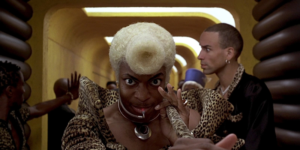
The Sound and the Fury
If you haven’t seen The Fifth Element in a while, you might forget just how crucial the audio work is to telling the story. There is a cacophony of sound the moment we meet the main character. An alarm is going off, a phone is ringing, the radio is playing, and a cat is meowing. The music playing over it all is an industrial, driving beat. Even when characters are talking, the music and sounds are consistently present in the background. There are distinct sounds for everything in the world, and things like the introduction of the sound a gun makes early in the film is rewarded with that sound being used later in the film, allowing the audience to clue in before the characters do. The failure of things make dying, farting sounds, while things that work have another distinct sound. There are sound cues that follow lines of dialogue that mark the perspective character’s reaction. Any time there is a reference to the Mondoshawans – or even has the Mondoshawan technology or information in the scene – part of the Mondoshawan theme is playing. When they are squaring off against the Mangalores, the Mondoshawan theme plays against the Mangalore theme, with the Mangalore theme taking prominence when the Mondoshawans are destroyed. When we next see the Mondoshawan artifacts, there is no theme being played, as they are currently out of the picture. This changes as the movie continues, and returns in later scenes.
Lest you think this is a one time occurrence, this sort of blending of themes persists through the entire film. The discordant industrial beat we see when we meet Korben blends with Leeloo’s theme when she escapes the facility and heads to the outside world…where she subsequently meets Korben. These two themes blend into a yet different theme entirely when Korben and Leeloo actually meet. This stuff is just as purposeful from a music standpoint as the action pieces being cued to very unusual music – techno-opera, industrial reggae, etc. Even these songs are built off each other if you listen to the musical underpinnings. The action blends into distinct songs from that point. The beginning of the car chase scene has elements of Leeloo’s theme, Korben’s theme, and the rhythm is that of the Plavalaguna opera song. When the chase kicks off in full, it’s Korben’s theme that drives it, telling you that Korben is going to be the primary actor. This sort of stuff is absolutely incredible and is one of my favorite things about the film. It is also, by the way, one of the things I love about John Wick and John Wick 2. I don’t think this gets enough love, and it’s absolutely why you probably love some of the movies you love. Let’s fight about it.
I know many people have talked about soundtracks for your games, but this is a conscious step to go further. It’s using musical cues as a means convey information to your players. Is this ruins part of the Luef people – the sounds can tell them. Most virtual tabletops allow for multiple songs to be played at the same time, so cueing up multiple songs so the players could get a thrill right before Dame Vastol appears is totally possible. This sort of sound cueing isn’t done nearly as much as it could or should be done, frankly. Giving distinct sounds to each of the primary NPCs, cultures, and so on does a lot to define the setting you have created with only minimal lifting. Even beyond mood setting – such as the use of the slightly daffy theme for the military in the film – the instruments, melodies, rhythms, etc. tell us so much about the people and cultures. For example, someone dressed in a black suit listening to heavy metal is going to convey a different message than someone in a black suit listening to classical music. This is absolutely about messaging and shorthanding, as depth will come from individual characterizations.
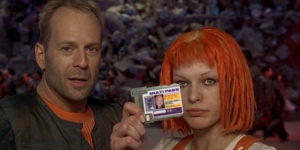
It’s Got Great Character
As basic as the story is, it feels like so much more thanks to the rich characters that we get. Korben Dallas is a military man who got out not because of something tragic or violent, but because it ruined his marriage and he wants a chance at finding love. He is gifted at the skills required of being in the special forces, and displays a quick wit and penchant for improvisation and clever action. He is depicted as having the instincts of a protector, but doesn’t come across as oozing machismo or anything. Leeloo confuses him and he wants to protect her, but he doesn’t treat her disdainfully when she says he is going to protect him instead. During the climax of the film, it’s Korben who gives the impassioned speech in favor of life and love. Nevermind the fact it is normally the woman who would be giving this speech in other films. This doesn’t seem out of place for him, because he’s been a big softie for the entire film. He’s a rich character who feels lived in and displays several facets throughout the film.
Ruby Rhod is another great example. He is the personification of shock jock-tv personality taken to a logical point in the future. He’s brash, in your face, stylish as hell, and is exuding sex-appeal. He’s Prince meets David Bowie meets Howard Stern. He has a team of people around him constantly to tell him how great he is…but the moment he’s under real stress and the team is gone, he’s unsure of himself and it’s easy to see how his personality falls apart. He needs the support of those around him to perform at even the barest degree. Only by appealing to his celebrity nature and repeating some of his affirmations back to him does Korben get Ruby Rhod to assist him. At the end of the film, once there is no more peril and he can be a little more sure of himself again, he reverts to the personality he had at the beginning of the film. It’s completely alright that he does that. His arc shows that he has grown and can depend and contribute to other people, but his bluster returns to show that he still has room to improve.
These solid, well-performed (seriously, someone thought Chris Tucker wasn’t amazing as Ruby Rhod?) roles add so much to the rote nature of the film. It’s not a surprise that these characters are so memorable. It seems like a simple thing, but it’s often forgotten about in games. It’s not just that these characters have backstories or motivations. They each have their own arcs that are consistent with their characterizations. Even more so, they are not just stereotypical roles. Korben is a subversion of some of the action hero tropes, but he feels lived in a character. He still does all the action hero-y stuff, but it’s all underpinned by his feelings – ones that he fully expresses and does not repress, FYI. Ruby Rhod is a twist on the sexy and loud-mouthed sidekick tropes. Again, he feels like a fully fleshed out character because his motivations are ones recognize and can easily see existing in this future. This is exactly how all characters for your homebrewed campaign – and all campaigns, really – should behave. They should feel lived in and informed by the world. Motivations aren’t enough. Their actions should be dictated by their experiences, and how those experiences were shaped by living in the world you design. If the jungle is a terrifying place, those who served in the military that went there need to not just talk about how the jungle is awful, but do things like bury all traces of their passing, never want fires, set extra watches, always be sharpening blades, etc. Those might seem trope-tastic, but it’s a simple way to convey experiences. This is crucial to getting across the appropriate message.

“But You Just Said…”
I know I just said the characters weren’t necessarily stereotypes, and they aren’t. That said, the use of archetypes is incredibly strong, and allows the characters to subvert expectations all the more strongly. I don’t think anyone would dispute Korben is a good example of a paladin or warrior, Ruby Rhod is a bard, Vito is a scholar, or Leeloo is a magic-user/magical girl. When Leeloo breaks bad and does all of the kung-fu she learned from watching videos, she breaks out of the mold of just magic-user. When she’s the one arguing for the end of the world because it’s not worth saving, it moves a bit away from the female romantic lead and magical girl aspects. This doesn’t mean she still isn’t that archetype, but just that she has subverted it in a meaningful way that serves her character. Without the archetypes being presented, the movie would have a lot more issues.
This is because archetypes are a tremendously helpful way to short-hand. Having a set of preconceived notions to play around with allows the audience to quickly understand the basic places from which the character will act, while also providing an understanding of what should be surprising. I want to reiterate that I do not necessarily think it is as simple as Korben = action hero = paladin or anything. Just that understanding what to expect from a paladin is a good place to jump off from when discussing the character or watching the film. Archetypes serve exactly this purpose. It’s way for us to contextualize what is occurring, and not a bad thing that means the characterizations are lazy. It’s just the opposite. It lets us see how these characters are different and express their own unique personalities and traits.
Take Jean-Baptiste Emmanuel Zorg (please!). He’s a mustache twirling villain, sure, but his motivations are easily digestible. He runs a company, he wants it to be financially successful, and he has aligned with an unknown entity he suspects is actually pure evil to achieve his ends. However, it’s clear his hubris is one of his defining characteristics from moment one, and his inability to control situations drives him insane. As the film progresses, these traits come more and more into the forefront, showing him as more and more desperate. His urbane personality comes undone and he unravels completely once he realizes his money and power don’t allow him to achieve the goals set before him. It’s his treatment of the Mangalores that proves his undoing, which isn’t a surprise given his total dismissal and betrayal of them previously. While this is all typical villain stuff – he’s basically space Kingpin – it’s done with a relatable charm and flair that is easy to believe. Like the other characters, he’s an archetype that feels well lived-in.
This is exactly what you want to bring to any and all characters in your campaigns – though especially homebrewed. You want to make them easily identifiable, but ensure they capable of embellishing that rudimentary outline the archetypes provide. The reason this is more important in a homebrew campaign is that there is no previously defined setting material for the players to reference. You can’t even say “typical elves” because there is no context beyond attempting to compare it to other settings. Does the phrase mean moon or sun elves from Forgotten Realms, or does it mean the Qualinesti from Dragonlance or just Tolkien elves? Even if you specify moon elves, there’s a lot of cruft there that then needs to be jettisoned. This changes dramatically if you present the elves based on archetypes – say “conservationists fed up with the ravages of man” – and then spin it to subvert that – “they seek to constantly educate man and subtly reshape the land when man intervenes.” This is just one quick example, but it defines the elves as ecologically-concerned, but they want man to join them in this belief, rather than fighting against them. Immediately, it changes the elves from aloof and opposing to potentially allied and mentoring. It’s from the same archetype, with a small shift. You understand what I am getting at. All of my readers are incredibly good looking and intelligent.
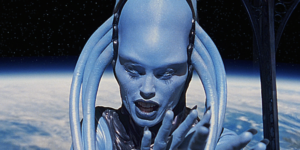
The Sixth Element
The real secret here is that every original novel or movie is just a homebrewed campaign world. It’s not even really a secret. A good movie or novel leaves the audience wanting more, and that’s exactly what a good homebrewed campaign does. The players should be clamoring for more, even if it’s not always to “learn more.” I guarantee you the players are always going to learn more about the world as they play the game. It doesn’t have to be information heavy to cause that to be true. Taking the above lessons from The Fifth Element is a great way to get buy-in to your homebrewed campaign faster, and improve it. The Fifth Element is an iconic film for a reason. I am not suggesting your homebrewed campaign will reach the same audience as the film, but I am suggesting you can make it of a similar quality.
To cap this all off I just want to say one further thing. Don’t let anyone tell you running a homebrewed campaign is bad or lesser. Don’t let anyone tell you running “unofficial material” is somehow lesser. D&D is made so you can make your imagination be a place you can share with others. Your stories are not less meaningful because you are not published. Your stories are not worse because you aren’t famous. As long as you are always working for your players to have a great time and you want to improve, you are a good as anyone else.
Leeloo might have been the perfect human being, but it took a broken-hearted run-down cab driver to help her realize it.

